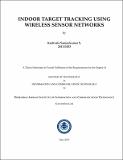Indoor target tracking using wireless sensor networks
Abstract
In this thesis, we consider indoor target tracking using wireless sensor networks (WSNs). In outdoor environment, target tracking can be done using Global Positioning Systems (GPS). But in the indoor environment this option lacks the desired accuracy. Therefore, we consider indoor target tracking using WSNs. We consider received signal strength indicator (RSSI) measurements for tracking owing to its simplicity due to lack of synchronization, that is required for other tracking metrics. Radio frequency identification (RFID) tags are mounted on different targets. The RFID tags emit beacons that are received by sensor nodes deployed in the tracking region of interest. The RSSI value obtained for every successful beacon frame received can be used for computing the position estimate of targets.
The state of every target that comprises of its location in D-dimensions and the corresponding velocity in each dimension is assumed to evolve according to a first order Markov chain. Further, the state is assumed to evolve according to a linear model. The RSSI measurement associated with every target is a nonlinear function of the target state. Thus, we have a linear state evolution model and a non-linear measurement model. The targets state can be estimated using a bank of particle filters. To improve the accuracy of tracking algorithm the maximum likelihood estimates of the underlying radio environment is used. Thus, the mixed Bayesian-ML based tracking algorithm is robust to the time-varying nature of radio environment and thereby provides better tracking accuracy. We also considered a distributed implementation of the centralized tracking algorithm that is scalable for large scale WSNs. Simulation results demonstrate the efficacy of the proposed approach.
Collections
- M Tech Dissertations [923]

